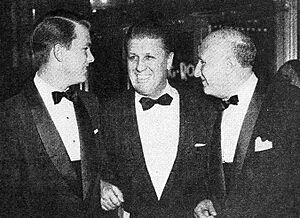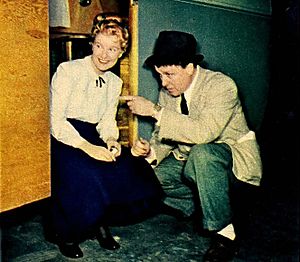George Stevens facts for kids
Quick facts for kids
George Stevens
|
|
|---|---|

Stevens with his Oscar for directing Giant, 1957
|
|
| Born |
George Cooper Stevens
December 18, 1904 Oakland, California, U.S.
|
| Died | March 8, 1975 (aged 70) Lancaster, California, U.S.
|
| Resting place | Forest Lawn Memorial Park, Hollywood Hills |
| Occupation |
|
| Years active | 1915–1970 |
| Spouse(s) | Yvonne Howell (1930–1947) Joan McTavish (1968–1975) |
| Children | George Stevens, Jr. |
| Awards | Academy Award for Best Director
Legion of Merit |
| Military career | |
| Allegiance | |
| Service/ |
|
| Years of service | 1943–1946 |
| Rank | |
| Unit | |
| Battles/wars | World War II
|
| Awards | |

George Cooper Stevens (December 18, 1904 – March 8, 1975) was an American film director, producer, screenwriter, and cinematographer. He was a very talented filmmaker.
Many of the movies he produced were nominated for the top award, the Academy Award for Best Motion Picture. He himself was nominated five times for Best Director, winning the Oscar twice!
Some of his most famous films include Swing Time (1936), Gunga Din (1939), and the five movies for which he was nominated for Best Director: The More the Merrier (1943), A Place in the Sun (1951), Shane (1953), Giant (1956), and The Diary of Anne Frank (1959). He won Best Director for A Place in the Sun and Giant.
Contents
The Life of George Stevens
Early Life and First Steps in Film
George Stevens was born on December 18, 1904, in Oakland, California. His parents, Landers Stevens and Georgie Cooper, were both actors on stage. He learned a lot about acting and theater by watching them. When he was 10, his mother gave him a Brownie camera. He loved taking pictures of his city and his mother.
At 17, George got a job at Hal Roach Studios. He started as an assistant cameraman. He even helped famous comedian Stan Laurel get his start in movies. George worked as a cameraman and writer for 35 short films starring Laurel and Hardy. He learned that comedy could be "graceful and human" from this experience.
In 1930, he married Yvonne Howell. In the early 1930s, George wanted to make movies with more developed characters, not just silly comedy. This led him to leave Hal Roach Studios. In 1933, he directed his first full-length movie, The Cohens and Kellys in Trouble.
Directing Big Stars
In 1934, George Stevens joined RKO Pictures. He directed a comedy called Kentucky Kernels. His big chance came when he directed Katharine Hepburn in Alice Adams the next year. He went on to make seven films for RKO in five years.
In the late 1930s, he directed famous dancers Fred Astaire and Ginger Rogers in the musical Swing Time. In 1939, he directed Cary Grant in the big adventure film Gunga Din. This movie cost a lot of money, but it was a huge success! In 1942, he worked with Katharine Hepburn again on Woman of the Year.
Serving in World War II
George Stevens was the president of the Screen Directors Guild from 1941 to 1943. After seeing a Nazi propaganda film, he felt he had to join the Allied forces in World War II. He joined the U.S. Army Signal Corps in 1943. He led a special film unit that recorded important moments of the war.
His unit filmed the Normandy landings, the liberation of Paris, and the meeting of American and Soviet soldiers at the Elbe River. They also filmed the discovery of the Duben labor camp and the Dachau concentration camp. This footage was very important. It was used in the Nuremberg Trials to show what happened during the war. In 2008, this footage was added to the U.S. National Film Registry because it was such an important record of the war.
Later Films and Awards
After the war, George Stevens returned to directing. His experiences during the war made his films more serious and dramatic. He directed the drama I Remember Mama (1948).
He went on to direct many classic films. These include the drama A Place in the Sun (1951), the Western Shane (1953), the epic Western drama Giant (1956), and the powerful Holocaust drama The Diary of Anne Frank (1959). He also directed the biblical epic The Greatest Story Ever Told (1965).
He finished his directing career with the romantic comedy-drama The Only Game in Town in 1970.
Personal Life and Legacy
George Stevens was the father of George Stevens, Jr.. His son also became a writer, producer, and director. George Stevens, Jr. founded the American Film Institute (AFI). He also made a documentary about his father called George Stevens: A Filmmaker's Journey in 1984.
George Stevens died from a heart attack on March 8, 1975, at his ranch in Lancaster, California. He is buried at Forest Lawn Memorial Park in Los Angeles.
Awards and Recognition
As a lieutenant colonel in the U.S. Army, George Stevens led the unit that filmed D-Day and the liberation of the Dachau concentration camp. For his important work, he received the Legion of Merit award.
George Stevens has a star on the famous Hollywood Walk of Fame. He won the Academy Award for Best Director twice:
- In 1951 for A Place in the Sun
- In 1956 for Giant
He was also nominated for Best Director for The More the Merrier (1943), Shane (1954), and The Diary of Anne Frank (1959).
See also
 In Spanish: George Stevens para niños
In Spanish: George Stevens para niños


